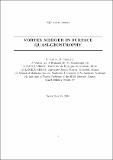Files in this item
Vortex merger in surface quasi-geostrophy
Item metadata
| dc.contributor.author | Carton, Xavier | |
| dc.contributor.author | Ciani, Daniele | |
| dc.contributor.author | Verron, Jacques | |
| dc.contributor.author | Reinaud, Jean Noel | |
| dc.contributor.author | Sokolovskiy, Mikhail | |
| dc.date.accessioned | 2016-12-24T00:32:19Z | |
| dc.date.available | 2016-12-24T00:32:19Z | |
| dc.date.issued | 2016 | |
| dc.identifier | 219079012 | |
| dc.identifier | 612dd8c6-9a94-4a20-bdd8-bc3d6a9a06a2 | |
| dc.identifier | 84958834074 | |
| dc.identifier | 000371645800001 | |
| dc.identifier.citation | Carton , X , Ciani , D , Verron , J , Reinaud , J N & Sokolovskiy , M 2016 , ' Vortex merger in surface quasi-geostrophy ' , Geophysical and Astrophysical Fluid Dynamics , vol. 110 , no. 1 . https://doi.org/10.1080/03091929.2015.1120865 | en |
| dc.identifier.issn | 0309-1929 | |
| dc.identifier.other | ORCID: /0000-0001-5449-6628/work/34852200 | |
| dc.identifier.uri | https://hdl.handle.net/10023/10016 | |
| dc.description.abstract | The merger of two identical surface temperature vortices is studied in the surface quasi- geostrophic model. The motivation for this study is the observation of the merger of sub- mesoscale vortices in the ocean. Firstly, the interaction between two point vortices, in the absence or in the presence of an external deformation field, is investigated. The rotation rate of the vortices, their stationary positions and the stability of these positions are determined. Then, a numerical model provides the steady states of two finite-area, constant-temperature, vortices. Such states are less deformed than their counterparts in two-dimensional incom- pressible flows. Finally, numerical simulations of the nonlinear surface quasi-geostrophic equations are used to investigate the finite-time evolution of initially identical and sym- metric, constant temperature vortices. The critical merger distance is obtained and the deformation of the vortices before or after merger is determined. The addition of external deformation is shown to favor or to oppose merger depending on the orientation of the vor- tex pair with respect to the strain axes. An explanation for this observation is proposed. Conclusions are drawn towards an application of this study to oceanic vortices. | |
| dc.format.extent | 22 | |
| dc.format.extent | 1761109 | |
| dc.language.iso | eng | |
| dc.relation.ispartof | Geophysical and Astrophysical Fluid Dynamics | en |
| dc.subject | Surface quasi-geostrophy | en |
| dc.subject | Vortex merger | en |
| dc.subject | Steady states | en |
| dc.subject | Critical distance | en |
| dc.subject | Shear/strain flow | en |
| dc.subject | Numerical model | en |
| dc.subject | QA Mathematics | en |
| dc.subject | NDAS | en |
| dc.subject.lcc | QA | en |
| dc.title | Vortex merger in surface quasi-geostrophy | en |
| dc.type | Journal article | en |
| dc.contributor.institution | University of St Andrews. Applied Mathematics | en |
| dc.contributor.institution | University of St Andrews. Scottish Oceans Institute | en |
| dc.identifier.doi | 10.1080/03091929.2015.1120865 | |
| dc.description.status | Peer reviewed | en |
| dc.date.embargoedUntil | 2016-12-23 |
This item appears in the following Collection(s)
Items in the St Andrews Research Repository are protected by copyright, with all rights reserved, unless otherwise indicated.

